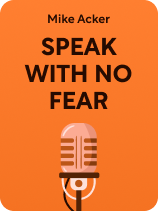

This article is an excerpt from the Shortform book guide to "Speak With No Fear" by Mike Acker. Shortform has the world's best summaries and analyses of books you should be reading.
Like this article? Sign up for a free trial here.
Are you terrified of speaking in front of others? What if you could overcome this fear and become a confident public speaker?
Speak With No Fear, a book by Mike Acker, offers strategies to conquer your anxiety about addressing an audience. Drawing from his extensive experience as a public speaker and coach, Acker provides practical advice for anyone looking to improve their communication skills.
Keep reading to discover how you can transform your fear into powerful, purposeful energy and deliver compelling speeches with ease.
Speak With No Fear Book Overview
Public speaking is the number one fear in the US, ranking above even the fear of death. Speak With No Fear, a book by public speaker and coach Mike Acker, explores why so many people are afraid to address an audience and provides seven strategies to help you overcome that fear. Acker promises that after working through these strategies, you’ll gain the confidence to become the strong, compelling speaker you’ve always had the potential to be—or at least to get through an upcoming event without wanting to throw up.
With a speaking career spanning more than 20 years, Acker has addressed audiences ranging from less than a dozen to thousands of people. Before that, he honed his skills as a student at Northwest University and a member of its world-class debate team. In addition to his public speaking work, Acker is a much sought-after communication coach whose clients include Fortune 500 companies, celebrities, churches, and relief organizations. He’s channeled that expertise into numerous self-help books about communication and leadership, the most popular of which is the bestselling Speak With No Fear.
In this overview, we’ll go over each of Acker’s seven strategies for overcoming the fear of public speaking. Since some of these strategies can help you to implement others more effectively, we’ve rearranged them into four “main strategies” and three “supporting strategies.”
Main Strategy #1: Dig Up the Root of Your Fear
Acker begins by saying that there’s probably a root cause behind your fear of public speaking—a humiliating or otherwise traumatic experience from your past that makes you afraid to stand up in front of a crowd. To fully overcome your fear, it’s crucial to identify that root cause and work through the negative feelings associated with it. Otherwise, this past event will continue to hold you back in the present.
For Acker, the root cause was obvious: He first tried public speaking in high school and his classmates viciously mocked his performance. However, the reason you’re afraid might not be so clear, so be prepared to dig into some of the most painful moments of your past. For instance, think about times when you became the center of attention for something embarrassing, times when groups of people made fun of you, or times when you were put on the spot for something you weren’t prepared for.
This is a difficult process, but an important one. A traumatic memory that you’ve buried is a bit like a broken bone that healed crookedly, Acker says—you have to re-break the bone and set it properly in order to make it whole and strong again. That’s what this first strategy does for your psyche: You go through that pain again so that you can truly recover from it.
How to Move on From Painful Memories
Acker says that when you find a memory that brings up the same feelings of fear and embarrassment you have about public speaking, you’ll need to do the uncomfortable work of reliving and processing those emotions so you can finally move on from them. For instance, one effective way to do this is through art: Write, draw, or craft something that tells the story of what happened and how it made you feel. However, if you’re truly feeling stuck in that memory and unable to move on, you might need to talk about it with a therapist.
Once you’ve gotten the uncomfortable feelings under control, Acker’s final suggestion is to look for a more positive way to think about that experience—perhaps there’s a lesson you could learn from it, or the pain helped to make you more resilient. Doing this will finally break that memory’s hold on you, allowing it to become a source of strength rather than a source of fear.
Main Strategy #2: Prepare for Disaster
Uncovering and healing from past trauma may be the most effective way to overcome your fear of public speaking, but it’s difficult and time-consuming, and therefore not practical if you’ve got a speaking engagement coming up soon. Acker’s second strategy—planning for the worst—is a much quicker fix. However, be aware that you’ll have to do this strategy all over again for each speech or presentation you give, since it only prepares you for one specific scenario.
For this second strategy, Acker advises you to intentionally imagine the worst-case scenarios that could happen when you give a speech or presentation. The idea is to purposefully make yourself anxious—which might sound counterintuitive, but doing so allows you to practice controlling your anxiety in a low-stakes environment. As an additional benefit, this strategy also allows you to plan out what you’ll do if that worst-case scenario happens to come up; having that plan in your proverbial back pocket will further bolster your confidence.
For example, perhaps your worst-case scenario is that you step up to the podium and realize you forgot your notes. Imagining that scene in great detail will let you practice controlling the panic and embarrassment that comes with forgetting something so important. Imagining that situation could also help you come up with a backup plan, like also putting those notes into your phone just in case you forget to bring the written copy.
Acker says to start by imagining all the details of the venue, audience, and the speech you plan to give, making your mental image as complete and as vivid as possible. Then, to build up your nerves and anxiety, think about how it could all go wrong. Next, practice calming techniques like deep breathing until the anxiety is gone (or at least manageable).
The author adds that, even if something does go wrong during your speech, it’ll rarely be as catastrophic as the scenario you imagined. Therefore, by preparing for the worst, you’ve over-prepared for whatever actually happens, and you’ll be able to handle any problems with ease.
Main Strategy #3: Do What Comes Naturally
The first two strategies we discussed were about preparing for a public speaking event; the remaining strategies focus on how to perform well at the event itself.
For his third strategy, Acker advises you to “be yourself” when giving a speech or presentation. He explains that too many speakers try to imitate the styles, mannerisms, and personas of other people instead of being their authentic selves. However, this approach just puts more pressure on them—since they’re now trying to give a performance as well as a speech—which inevitably leads to increased anxiety and a lack of self-confidence.
Instead, find and perfect your own intrinsic style. Your unique quirks, physicality, speech patterns, sense of humor, and overall personality are powerful assets when communicating, not flaws to be suppressed or replaced. Embrace them, and you’ll gain much more confidence than you could by imitating someone else.
Supporting Strategy #1: Find a Friend to Speak To
Acker advises you to be yourself when giving a speech, but it’s much easier to be yourself in front of a single friend than a large group of people you don’t know. That’s why his fourth strategy is to find a friend in the audience—or someone you can pretend is your friend—and imagine you’re speaking only to that person.
If possible, mingle with the crowd before your speech. Introduce yourself to a few people, learn their names, and try to form connections with them. Then, when it’s time for you to speak, you can look for those people in the crowd and deliver your speech to them. Doing so will give you some “anchors” in the audience; these people can provide specific places you can focus on so you don’t get overwhelmed by a crowd of strangers.
Furthermore, Acker says that your attitude toward your audience will inevitably come through during your speech. If the people intimidate you, they’ll pick up on your nervousness and conclude that you’re not a very good speaker; even worse, they might think that you don’t really know what you’re talking about. On the other hand, if you’re at ease like you would be while talking to a friend, your speech will be much better received.
Supporting Strategy #2: Think About Your Audience, Not Yourself
Another major reason you might feel uncomfortable during a speech, and therefore have trouble acting like your natural self, is that you’re too self-conscious. That brings us to Acker’s next strategy: Think about your audience instead of yourself. The more you shift your focus away from yourself, the less anxious you’ll be.
Acker says that you can do this by trying to empathize with the audience. Think about why they’ve come to listen to you—what are they hoping to gain from your speech? Consider what hopes they might have that you could help them fulfill, or what fears they might have that you could assuage. If possible, ask them questions to see what’s on their minds.
For example, if you’re presenting your company’s quarterly sales and profits, your audience is probably hoping for bonuses and afraid of being laid off, so think about how you’ll address those concerns.
Also, to connect with your audience more effectively, observe them while you speak. Periodically check whether they’re paying attention or seem to be getting restless and try to adjust accordingly. If they’re getting bored then it might be time to move to a new topic, break up the monotony with a joke, or wrap up your speech.
Main Strategy #4: Use Your Nervous Energy
No matter how effectively you use these strategies, you probably won’t completely get rid of your nervous feelings. However, Acker argues that’s actually a good thing—you’re nervous because you care, and because you want to do well. Furthermore, you can harness that nervous energy to deliver a more forceful, more passionate speech than you could ever give while you’re totally calm.
The author says that the key to using your nervousness effectively is intent. Remember why you’re there and what message you’re trying to convey, and focus your nervous energy on that intention. Use the energy to invigorate your words and your movements. Even the pauses in your speech should be purposeful; they’re a chance for you to take a breath and recenter yourself.
Conversely, if you don’t have a focused intent, you’ll just waste that energy on anxious fidgeting and pacing—in other words, your energy will work against you instead of working for you.
Supporting Strategy #1: Focus on the Here and Now
Acker says that the key to harnessing your nervous energy is to keep your purpose in mind; the most effective way to do that is to keep your attention on the present moment, instead of regretting the past or worrying about the future. In fact, you can practice this strategy during every step of public speaking.
First, while you’re preparing and writing your speech, don’t get impatient and wish that the speaking event would come sooner. Instead, relish the chance to learn more about the topic and practice your speaking skills.
Then, during your speech, don’t distract yourself by thinking about what else you wish you’d included in it, or by worrying about what you’re supposed to say next. Remember: Your audience doesn’t know what you wrote, so it doesn’t matter whether you follow the script word for word—a strong sense of purpose and a genuine connection with your listeners are much more important.
Finally, once your speech is over, accept whatever happened and move on. Remember that you did the best you could in that moment, and stressing about it after the fact won’t change anything. You can celebrate what went well and identify things that you could improve upon for next time, but the most important thing is this: Savor the fact that you faced your fear, you gave the speech, and now your life goes on.
Exercise: Start Overcoming Your Fear
Now that you’re familiar with Acker’s strategies for overcoming the fear of public speaking, think about how you could use some of his advice to conquer your own fear.
- Choose one of Acker’s seven strategies that you’d like to practice. Which one did you choose, and why? Remember, the strategy that’s most practical for you may depend on how long you have until your next speaking engagement.
- What can you do today to start putting that strategy into practice? For example, say you chose “Think About Your Audience, Not Yourself.” You might start by writing down the topic of your speech, along with three things your audience might be hoping to gain from it and three concerns they’re likely to want addressed.
- How will you implement that strategy on the day of your speech or presentation? Make sure to include some specific actionables, not just your goal for the day. Continuing the previous example, you could make a point of watching your audience while you speak and adjusting to their mood. It will help if you plan ahead—think about specific cues to watch for and how you’ll respond to those cues. For instance, if a lot of people are checking their phones, you might need to wrap up the current section as quickly as possible and move on.

———End of Preview———
Like what you just read? Read the rest of the world's best book summary and analysis of Mike Acker's "Speak With No Fear" at Shortform.
Here's what you'll find in our full Speak With No Fear summary:
- How to become a confident and compelling speaker
- How to plan for the worst when you’re speaking on stage
- Why people in the US fear public speaking even more than death






